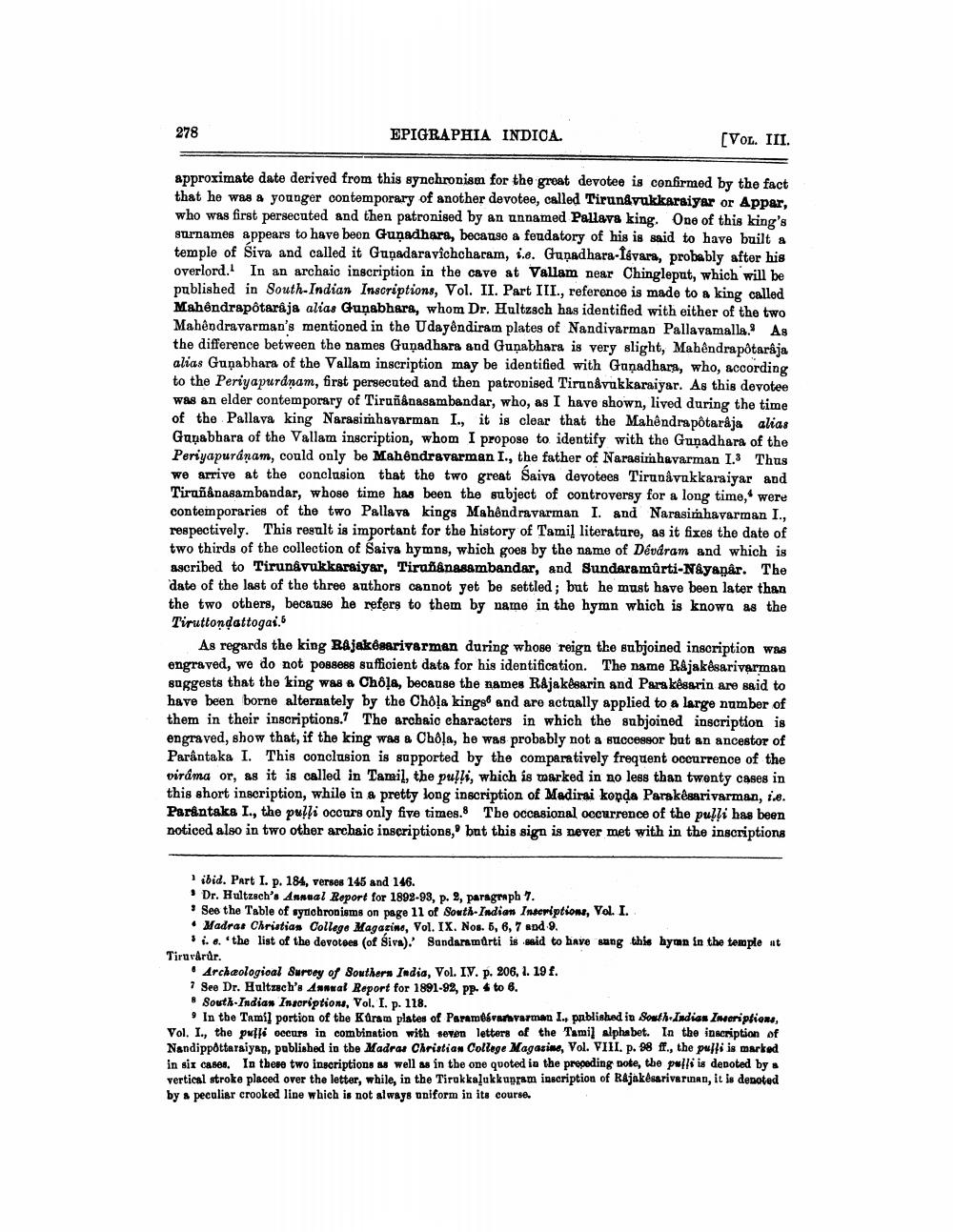________________
278
EPIGRAPHIA INDICA.
[VOL. III.
approximate date derived from this synchronism for the great devotee is confirmed by the fact that he was a younger contemporary of another devotee, called Tirunavukkaraiyar or Appar, who was first persecuted and then patronised by an unnamed Pallava king. One of this king's surnames appears to have beon Gunadhara, because a feudatory of his is said to have built a temple of Siva and called it Gunadara vichcharam, 1.6. Gunadhara-Isvara, probably after his overlord. In an archaic inscription in the cave at Vallam near Chinglepnt, which will be published in South Indian Inscriptions, Vol. II. Part III., reference is made to a king called Mahendrapôtarája alias Guņabhara, whom Dr. Hultzsch has identified with either of the two Mahêndravarman's mentioned in the Udayêndiram plates of Nandivarman Pallavamalla. As the difference between the names Gunadhara and Guņabhara is very slight, Mahendrapôtaraja alias Guņabhara of the Vallam inscription may be identified with Gunadhara, who, according to the Periyapurdnam, first persecuted and then patronised Tiranåvukkaraiyar. As this devotee was an elder contemporary of Tiruñanasambandar, who, as I have shown, lived during the time of the Pallava king Narasimhavarman I., it is clear that the Mahendra potarâja alias Ganabhara of the Vallam inscription, whom I propose to identify with the Gunadhara of the Periyapuranam, could only be Mahendravarman I., the father of Narasimhavarman 1.3 Thus we arrive at the conclusion that the two great Saiva devotees Tirunavukkaraiyar and Tiruñânasambandar, whose time has been the subject of controversy for a long time, were contemporaries of the two Pallava kings Mahendravarman I. and Narasimhavarman I., respectively. This result is important for the history of Tamil literature, as it fixes the date of two thirds of the collection of Saiva hymns, which goes by the name of Déváram and which is ascribed to Tirunavukkaraiyar, Tirananasambandar, and Sundaramûrti-Nyapar. The date of the last of the three authors cannot yet be settled; but he must have been later than the two others, because he refers to them by name in the hymn which is known as the Tiruttondattogai.
As regards the king Rajakesarivarman during whose reign the subjoined inscription was engraved, we do not possess sufficient data for his identification. The name Rajakesarivarman suggests that the king was e Choļa, because the names Rajakesarin and Parakesarin are said to have been borne alternately by the Chôļa kings and are actually applied to a large number of them in their inscriptions. The archaic characters in which the subjoined inscription is engraved, show that, if the king was a Chola, he was probably not a successor but an ancestor of Parantaka I. This conclusion is supported by the comparatively frequent occurrence of the viráma or, as it is called in Tamil, the pulli, which is marked in no less than twenty cases in this short inscription, while in a pretty long inscription of Madirai konda Parakesarivarman, i.e. Parintaks I., the pulli occurs only five times. The occasional occurrence of the pulli has been noticed also in two other archaic inscriptions, but this sign is never met with in the inscriptions
ibid. Part I. p. 184, verses 145 and 146. • Dr. Hultzsch's Annual Report for 1892-93, p. 2, paragraph 7. * See the Table of syrobronisms on page 11 of South Indian Insemiptions, vol. I. • Madras Christian College Magarino, Vol. IX. Nos. 5, 6, 7 epd 9.
si..the list of the devotees (of Siva). Sandaramurti is said to have sang this hymn in the temple at Tirurarår.
• Archeological Survey of Southern India, Vol. IV. p. 206, 1. 19 f. 7 See Dr. Hultzach's Annual Report for 1891-92, PP. 4 to 6. # South Indian Inscriptions, Vol. I. p. 118.
. In the Tamil portion of the Kdram plates of Paramosvan varman I.. published in South Indian Inveriptions Vol. I., the puiki oecurs in combination with seven letters of the Tamil alphabet. In the inscription of Nandippottaraiyap, published in the Madras Christian College Magasine, Vol. VIII. p. 98 ff., the pulli is marked in six cases. In these two inscriptions M well as in the one quoted in the propeding note, the pulli is depoted by vertical stroke placed over the letter, while, in the Tirukkalukkuram inscription of Rajakesariver , it is denoted by s peculiar crooked line which is not always uniform in its course




